The Bergans take the top spot in a highly competitive Worlds fleet during a week that offered sun and wind for all five days of racing in central Puget Sound.
The Seattle-based pair of Dalton and Lindsay Bergan won the Tasar World Championship on Puget Sound over the third week of September. Seattle teams dominated the top spots, showing off what two-and-a-half years of tuning, rigging, and technique refinements can do to advance a class. Dalton and Lindsay’s excellent starts, consistently cunning decision-making, and all-around speed kept them ahead of Jonathan and Libby McKee often enough to take the win. This is the first Tasar Worlds victory for Dalton and Lindsay; and it is Dalton’s second world title of the year, following his Aero victory in June.
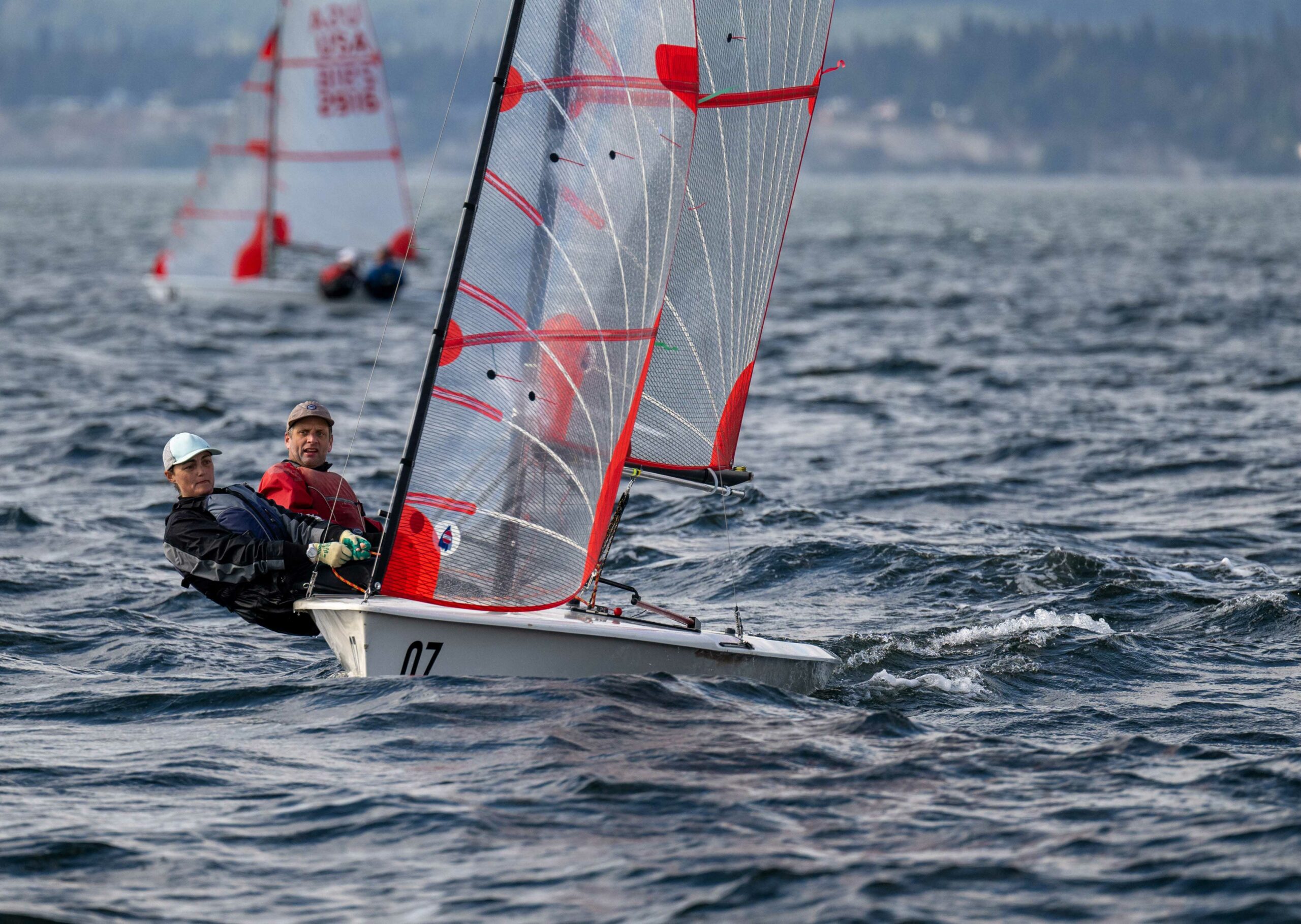
The racing area was about a mile north of Meadow Point, where the Sound broadens into a more open venue away from the shoreline bluffs. The fleet of 30 boats raced primarily on triangle-windward-leeward courses (triangle first, followed by one upwind and one downwind leg to finish) targeting 50 minutes in duration. The wind mostly cooperated with the schedule of three races per day, allowing 13 total with two throw-outs. Former World Champion Chris Dance of Australia said the Sound is “a fair and even championship venue” with a good mix of conditions. Steep chop on some days was greeted both for its modesty (Ryo Uematsu of Japan praised its small size, presumably relative to the deranged tidal swell of the last Worlds) and for its playful surfing potential off the wind.

Some hardened Seattle locals smirked at the arrival of three consecutive days of 15-knot northerlies, good waves, clear skies, and 75 degrees over the check-in and practice days. “The weather was awesome!” raved Mahoro Sekiguchi, sailing her 10th consecutive Tasar Worlds as skipper of the sole team able to attend from Japan, “even though we know it is exceptional.”
As the northerly subsided over the first two days of racing, the current remained a perplexing swirl that didn’t always match the tide tables. “Picturesque!” one Australian skipper told me, then dropped his voice to a whisper, “but we won’t mention the weeds.” Racing began before noon every day, so local thermals and the real northerly from the Strait competed with each other. With that weather setup, the left side of the course nearly always paid upwind as the northerly eventually became the dominant wind angle. With a fairly clear left-side bias, starts were extremely competitive especially at the pin — three of the top 10 boats showing the three dreaded letters (OCS) in the penultimate race.

On the first day of racing, Jonathan and Libby McKee won two of three races; while Dalton and Lindsay won the other but sailed a throw-out by going the wrong way upwind in a dying breeze. Day two saw Dalton and Lindsay winning all three races, landing them atop the standings for the remainder. Jay and Lisa Renehan sailed several consecutive top-five finishes to establish a third place position, and Stasi Burzycki and Sophia Kasper sailed a series of top 10s as they took on Anthony and Haley Boscolo and Alyosha Strum-Palerm and AnaLucia Clarkson in the battle for fourth place, which was ultimately decided by a four point gap among the three boats.
Day three brought a gusty southerly and cloudy skies. The wind was 11-16 knots with both oscillating and persistent shifts. Staying middle-left meant you would not totally miss a persistent lefty, but many boats made gains by ducking to dig in farther left. Later in the day, the arrival of right shifts and puffs balanced the race course, and by the end of the day the right side provided a current advantage. I caught Jonathan McKee in line for seconds at dinner aboard the historic steamship Virginia V on regatta party night to ask him what to do. He suggested your position on the racecourse can guide decision-making when you can’t tell if your puff is a persistent or oscillating shift. “If you are in the middle of the course, taking a new puff farther to a side might be okay,” he advised, “but if you are already left of the boats you’re racing against, safer to be on the right tack for the angle.”
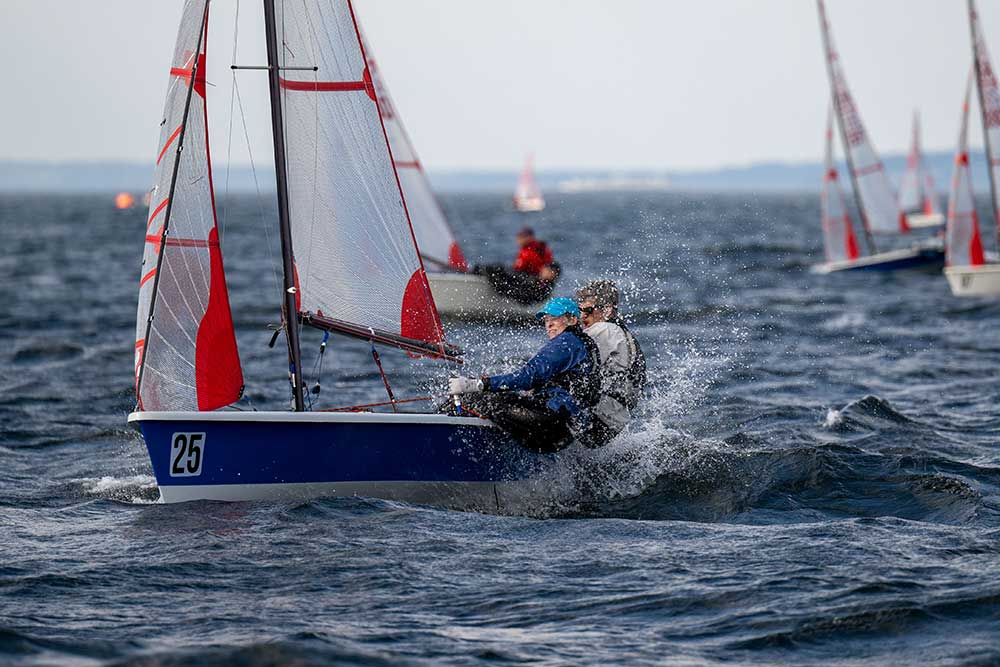
Downwind in these gusty and windy conditions rewarded close teamwork. Some teams made big gains when the crew called puffs and the pair worked together to trim both sails for the arrival of the gust, adjust their body weight to keep the heel angle steady through accelerations, and send the boat over as many waves as possible before re-settling in the lull and driving to the next gust. Jill Wynott of British Columbia observed that top boats all demonstrate such close teamwork and that her boat focuses specifically on this process.
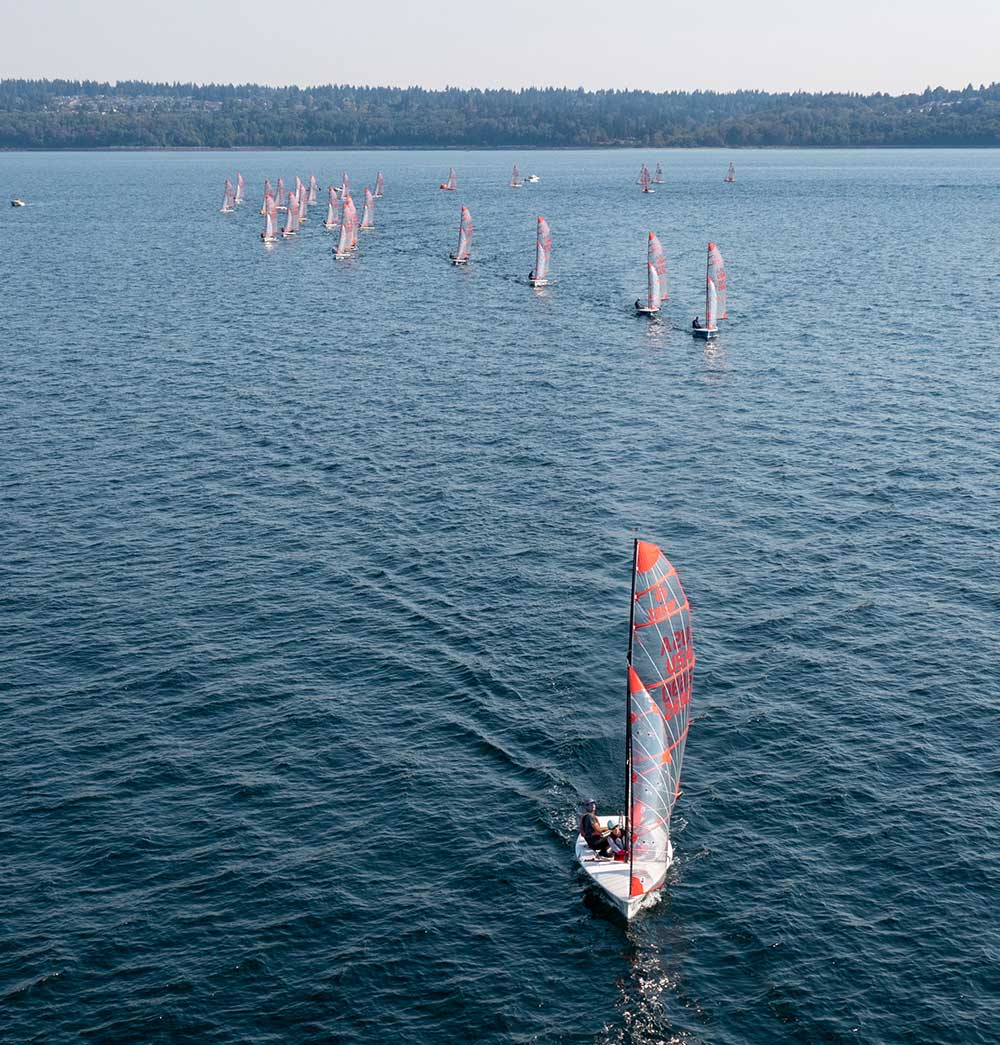
Reaches were race-changers in light air as well. The Tasar is underpowered and large differences in apparent wind and angle develop in these conditions. The feel for building speed with small stiff sails on high aspect foils is not something you can learn in the boatpark, to say the least. While one experienced sailor new to the Tasar told me his best race was when they developed a feel for speed on the reach leg “and managed to not get rolled by the whole train of the fleet,” going high was far from the only thing to do. Courageous or confident teams would dive very low right at the mark, escaping some bad air while presumably refusing to look up at the fleet rolling them. Because passing to leeward within 3-4 boat lengths is nearly impossible, a cluster of boats sailing the high route could only sail as fast as its slowest member and would usually sail too high as well. The brave low-mode boats could make big gains by sailing in less congestion and reserving some speed-gain late in the leg by turning up for the final approach to the gybe mark. Risk-averse sailors splitting the difference between the high train and the low mode got the worst of both worlds: too close to escape the bad air and not high enough to keep your place in line.
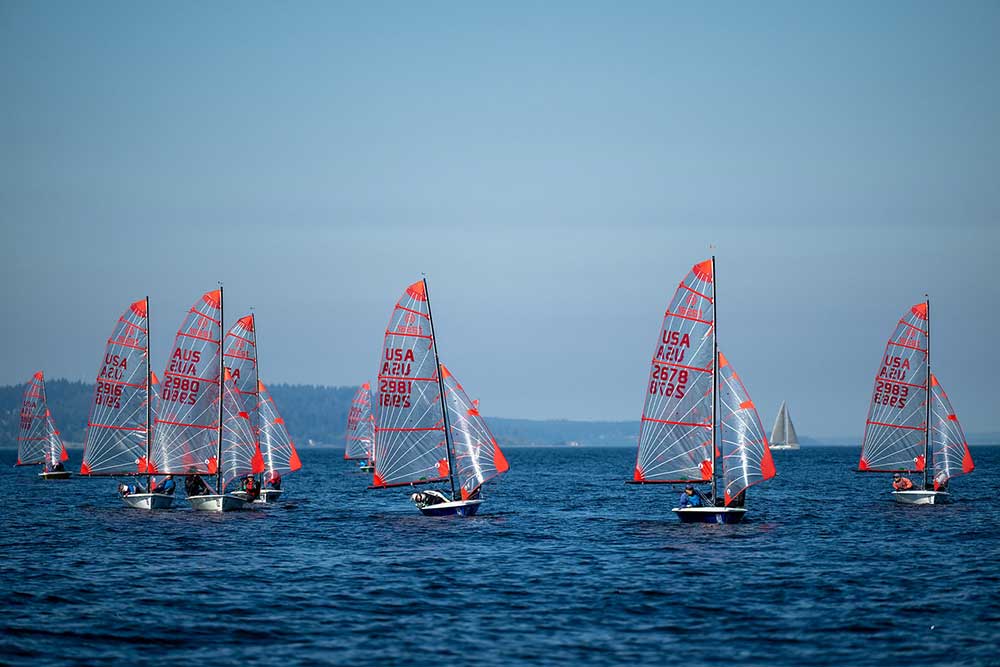
The Seattle fleet extended its habit of holding a post-racing debrief to the entire Worlds field. A competitor was appointed each day to lead a discussion of the day’s racing, quizzing the leaders on key elements of their successes and fielding questions from the fleet. Race winners shared their rig and trim settings, strategic decision-making indicators, and race course observations. We learned that Sophia Kasper clips the whisker pole to the jib on the final approach to the windward mark if they plan a gybe-set, something apparently nobody had considered before. Hanna Brush, one of a dozen recent college sailing graduates finding a home in the Tasar fleet in the past couple years, learned about adjusting shroud tension, jib tack height, and batten tension for the day’s conditions. “It’s taken a while for me to transition from the ‘set it and forget it’ mentality to being more observant and proactive with the boat’s settings. Peter Hackett, 2015 World Champion, led one debrief and later commented “it is obvious the Seattle squad is well practiced.” Pete extracted an admission from one boat that they intentionally turtled to pull eelgrass out of the back of their centerboard trunks. This seems extreme, but dragging weeds is an enormous detriment to boat speed.
Francois Hebert, of Whistler, BC, raved that the class wants to develop all its sailors. “The knowledge sharing is something special. While the top boats in BC do talk after racing, it is not the same level as the focus on improving in the Seattle fleet.” Among the boat setup innovations since the last worlds are that many teams put the centerboards all the way down in light air (6” lower than the standard board position of my youth), and some bored forward hands adjust the mast rotation for different downwind angles. I think teams sheet the jib tighter now too as the Seattle fleet strives to sail closer to the wind.
The event was more than just racing, though. Behinds the scenes, Worlds organizers targeted a Platinum certification from Sailors for the Sea, whose recommendations for a more environmentally responsible regatta resulted in lower waste and healthier event. In addition to specifying more environmentally conscious products and processes, the Tasar fleet partnered with a graduate student at Seattle University to develop the first regatta carbon footprint calculator. The calculator measured the carbon impact of the Worlds and guided the purchase of offsetting carbon credits. The tool is now available to any regatta organizers.

In another first for a major championship, the Worlds used Mark Bots instead of the more traditional buoys. The Bots are inflatable catamarans with electric motors and a mark-shaped body visible from a distance. Deployed after a tow to the racecourse, their location can be set by a phone app. Ben Glass, the human PRO, remained in control of the bots for the entire event. The water depth in the race course was 500’ to 900’ making traditional marksetting difficult. The adaptability of race management with the Mark Bots was frequently employed — I never once reached the leeward mark without a committee boat signaling a change of windward mark position, primarily for regulating race length. Ben is ready to work on a software update so the Bots can position themselves based on relative angle and distance from the signal boat rather than absolute position. The signal boat still swings on thousands of feet of obsolete anchor line.
Three parent-child teams raced the Worlds, with the White Salmon, WA duo of Andy and Lauren Mack finishing top in this category at 13th overall. Teams that are apparently couples took the top six spots. The top female skipper was Heather Macfarlane in 12th, though AnaLucia Clarkson drove her boat on the downwinds to 6th place. Chris Dance and Peter Hackett were the top all-male team in 8th place. One fully Junior team in the fleet — Dieter Creitz and Sam Bush — and they ended the week in 16th.
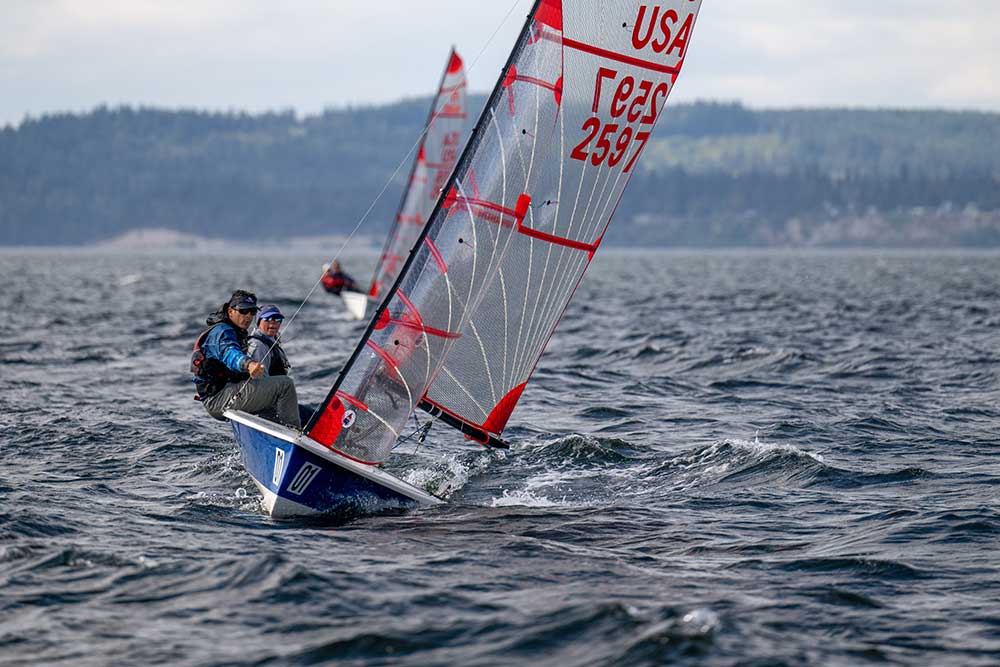
Tasars are sized right for couples, and many find the teamwork required to be at once infuriating and rewarding. One skipper racing with a crew newer to dinghies claimed the most rewarding part of the regatta was sailing with his partner and the prospect of doing it again sometime. The age range (from 15 to 70) and gender spectrum in Tasars makes for a lively social scene! All the teams I asked about the event loved the opportunities to meet the people they spent all day racing. With no translator, a Japanese sailor and I hand-crafted the winning tin foil boat at the CYC clubhouse (it floated 50 washers). And after hearing it from three international teams, I’ll never again take for granted that we get to push off the dinghy dock at Shilshole with dry feet.
The first Tasar World Championship held on the waters of the Salish Sea since 2003 was a smashing success. Thank you to Seattle Yacht Club for hosting a great event and for Corinthian Yacht Club for providing the on-the-water venue, and thanks to all the volunteers who made it possible. Congratulations to all the competitors and particularly to first-time Tasar world champs, Dalton and Lindsay!






